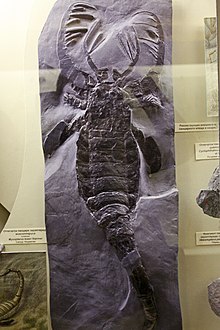The Mixopteridae are a family of eurypterids, an extinct group of chelicerate arthropods commonly known as "sea scorpions". The family is one of two families contained in the superfamily Carcinosomatoidea (along with Carcinosomatidae), which in turn is one of the superfamilies classified as part of the suborder Eurypterina.
| Mixopteridae Temporal range: early Silurian,
| |
|---|---|

| |
| Fossil of Mixopterus kiaeri exhibited at the Moscow Paleontological Museum. | |
| Scientific classification | |
| Domain: | Eukaryota |
| Kingdom: | Animalia |
| Phylum: | Arthropoda |
| Subphylum: | Chelicerata |
| Order: | †Eurypterida |
| Infraorder: | †Diploperculata |
| Superfamily: | †Carcinosomatoidea |
| Family: | †Mixopteridae Caster & Kjellesvig-Waering, 1955 |
| Type species | |
| †Mixopterus multispinosus Ruedemann, 1921
| |
| Genera | |
| Synonyms | |
| |
According to a 2024 paper, this family may be paraphyletic, containing modern scorpions.[1] However, the vast majority of phylogenetic analyses classify scorpions as arachnids, not eurypterids, making this claim unlikely.[2]
Description
editMixopterids were characterized by large exoskeletons with scattered tubercles or semicircular scales. The prosoma (head) was subquadrate, protruding antemedially. The chelicerae (claws in front of the mouth) were small. The first two pairs of walking legs were strongly developed, with long paired spines. The third and fourth walking legs were moderately sized, with short spines. The preabdomen, the front portion of the body, was narrow with axial furrows, while the postabdomen was narrow. The telson was a curved spine.[3]
Genera
edit- Order Eurypterida Burmeister, 1843
- Superfamily Carcinosomatoidea Burmeister, 1845
- Family Mixopteridae Caster & Kjellesvig-Waering, 1955
- Genus Mixopterus Ruedemann, 1921
- Genus Lanarkopterus Størmer, 1936
- Genus Terropterus Wang et al., 2021
- Family Mixopteridae Caster & Kjellesvig-Waering, 1955
See also
editReferences
edit- ^ Braddy, Simon J. (14 September 2024). "Carcinosomatoid eurypterid palaeoecology and phylogeny: ichnology and palaeocommunities". Neues Jahrbuch für Geologie und Paläontologie - Abhandlungen. 312 (2): 167–181. doi:10.1127/njgpa/2024/1206.
- ^ Waggoner, B. M. (12 October 1999). "Eurypterida: Morphology". University of California Museum of Paleontology Berkeley. Archived from the original on 23 October 2020. Retrieved 20 October 2020.
- ^ Størmer, L 1955. Merostomata. Treatise on Invertebrate Paleontology, Part P Arthropoda 2, Chelicerata, P34-P35.